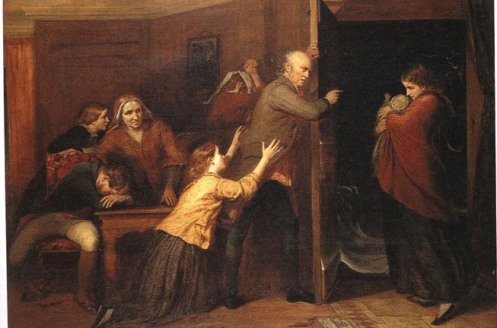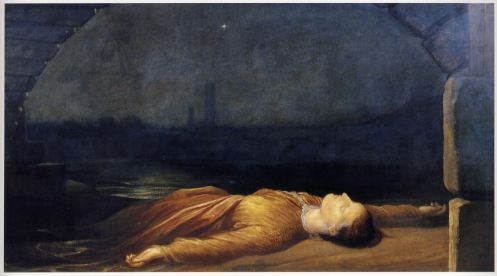Ruined!
Typical when one thinks of ruin they think of visual damage that occurs to a physical object or in reference to a particular subject; however, the idea reaches far beyond that of physical destruction. As we have discovered through the many classical works we have examined, ruin can be seen as a difference of opinion. Such works as “The Girl of the Period” indicates how one person may see something as ruined, like the ruined image of the innocent English girl in Linton’s case. If we look at it through the perspective of a male during the eighteenth century, he may have a different perspective since, in many cases, he was the one creating the “ruin.” A prime example of this can be found in Christina Rossetti’s “The Goblin Market,” where she tells the story of two innocent young girls who pass by the Goblin’s market and try to resist their tempting fruits. Until the oldest girl Lizzie falls for their temptations and becomes addicted to their fruits. After she succumbs to such temptations she has lost all her innocence and can now be viewed as ruined by society. The concept of “ruin” from a societal standpoint was weighed more towards women than men since women were the ones to bear the consequences of falling for temptation while men simply received a slap on the hand, if that. One common re-occurrence of symbolism we can witness through the different works of the nineteenth century would be the common use of fruit. Throughout Rossetti’s piece she repeatedly explains how their fruit invokes temptation to young girls and emphasizes the consequences of giving into temptation. This idea has a direct correlation to the biblical reference of the forbidden fruit in the Garden of Eden and how eating the forbidden fruit casts you out of a pure and holy world. For women who committed the sins of the flesh without being bound in matrimony were often cast out of their homes like Adam and Eden were cast out of the Garden of Eden. In the case of the women depicted in Richard Redgrave’s The Outcast, A woman who gave birth to a child out of wedlock was cast out of her Garden from her own family for tasting the forbidden fruit. Not only would she be condemned to life in cold solitude, but her child would be condemned along with her.
Another type of religious symbolism we could depict from such works would be the role of the head male of the household. In Redgrave’s painting the father clearly takes the authoritative role while one sister gets on her knees to plea for her father to forgive her sister. The male can be seen as a type of God of the household depicted by the sisters’ prayer-like stance and the way the father demonstrates his anger in a form of wrath like she has created the sin directly against his will rather than God himself. When women committed sins of the flesh or adultery they we punished more harshly than men. Women of this time harbor direct meaning to the phrase “ruin” in the sense that they are seen as ruined by the society that surrounds them, and their lives as a whole have been ruined. In George Frederic Watts painting “Found Drowned” the woman depicted committed a tragic suicide. She lived life poverty and, although the reasoning for the suicide is unknown, it became clear that she has lived a life of suffering and turmoil that defines her life as ruined. In Oscar Wilde’s The Harlot House a man and his wife walk past a harlot house that he describes as full of sin through his use of negative diction such as “The dance of shadows” and “grotesques.” Wilde describes the instance that his wife fell for the hypnotic music and how his love was drawn into the house of lust where she will see the error of her ways and come back to him “like a frightened girl.” In this instance the Harlot House is the forbidden fruit and Wilde’s wife has committed a sin by taking a bite of it. The women who work for the harlot house are viewed as ruined through the eyes of society. They represent temptation and sin, with their painted faces and their appearances. They are ruined for marriage through the eyes of the innocent English girl, and they are ruined to live in their family’s household through the eyes of their fathers. This is one of the many representations on how the concept of ruin can be considered a man’s word in a man’s world.
-Michelle Davis
Works Cited
Watts , George. Found Drowned. 1848-1850. Watts MediaWeb. 13 Dec 2012. <http://www.wattsgallery.org.uk/learning/teachers-resources/found-drowned>.
Redgrave, Richard. The Outcast. 1851. Victorian WebWeb. 13 Dec 2012. <http://www.victorianweb.org/painting/redgrave/paintings/4.html>.
Wilde, Oscar. “The Harlot House.” Victorian Web. Victorian Web, 27 2010. Web. 13 Dec 2012. <http://www.victorianweb.org/authors/wilde/harlot.html>.
Rosetti, Christina. “Goblin Market.” The Victorian Web. The Victorian Web, 07 2005. Web. 13 Dec 2012. <http://www.victorianweb.org/authors/crossetti/gobmarket.html>.


